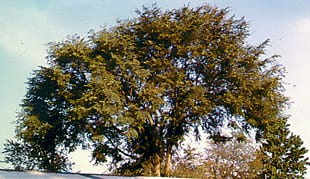WILT OF ELM
Dothiorella ulmi (imperfect fungus)
Common to American elms. Occasionally on slippery and Siberian elms located in central and eastern United States.
Wounding, insect punctures, pruning, compacted soil, drought, malnutrition, overhead irrigation, climbing spurs all add to infections.
The foliage yellows and wilts in scattered portions of crown with wilt becoming generalized throughout, followed by gradual dieback. Outer rings of wood have brown discoloration. Elliptical cankers on stems with small black specks of spore bodies (pycnidia). In wet weather, sticky spore masses accumulate around wounds or on leaves. Wilt symptoms resemble those caused by other wilt fungi. Laboratory isolation is necessary for positive diagnosis and identification.
There are sticky spore masses on leaves or twigs spread by wind, rain, overhead irrigation, and pruning. Infection usually through wounds on leaves, but may enter through stem wounds. The fungus moves down leaf petioles into twigs, entering and plugging vessels. Cankers develop around such infection sites. New pycnidia develop during summer and autumn, releasing spores during spring rains.


